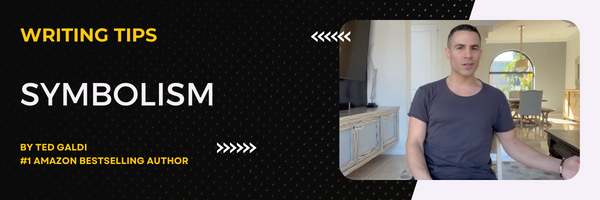Elevate Your Writing With Symbolism - Definition, Tips, and ExamplesSymbolism is a powerful tool. If you're writing a book or screenplay, you can use it to add emotional impact to your scenes. In this post, learn the definition of symbolism and tips for applying it to your story, with examples. Want to write an awesome story? Download my FREE outlining guide. What is symbolism in writing?Symbolism in writing is when an element of your story - such as a person, place, or object - represents an idea. The represented idea tends to play an important role in the story's character development, plot, or theme. For instance, in a war story, a pen might be a symbol for peace. Types of symbolism in writingTwo major types of symbolism exist in stories. I call the first outside symbolism and the second inside symbolism. With outside symbolism, an element of the story represents an idea that the characters in the story are unaware of - the meaning exists "outside" the world of the story. Let's say a writer was telling a story about a gang leader who causes a lot of violence in his city. The writer wants this gang leader to symbolize a certain god of destruction from an ancient myth. The writer goes on to give the gangster certain characteristics that represent the mythical god. For example, the mythical god has the skin of a serpent and the gang leader wears a snakeskin suit. The gang leader, however, is not aware of this representation, nor are any other characters. The symbolic effect exists outside the world of the story. With inside symbolism, a story element represents an idea that one or more characters are aware of. The symbolic effect exists "inside" the world of the story. Let's look at the example I gave earlier, about a pen symbolizing peace. In the story, a politician signs a peace treaty with the pen, preventing thousands of deaths. The politician cherishes the pen, carrying it in his pocket wherever he goes. Later on in the story, the politician's country is attacked. While fleeing from a bombing, he loses the pen. This moment signifies the "loss of peace." Below, find five tips for applying symbolism to your story. If you want even more writing advice, check out my online writing courses. #1 - Use symbolism to show character lossAs we just went over with the war-story example, the loss of the pen represents the loss of peace. You can create this effect in two steps:
If you're going to use this technique, be sure not to waste it on a minor idea. The loss of the element should signify a major setback for your protagonist or another significant character. In a war story, the loss of peace is a major turning point. If you were telling a crime story, the loss of presumed innocence could work. If you were telling a sports story, the loss of an athlete's health could fit. #2 - Use symbolism to show character gainThis technique is the flip side of tip #1. Follow these steps:
Like with #1, be sure not to waste this tactic on a minor idea. The gain of the element should signify a major win for a significant character. For example, let's say you're telling a story about a kid who's training to be a boxer. In his gym are two training sections, one for the experts, another for the amateurs. Early in the story, the kid accidentally steps onto the expert side and the boxers tell him to leave. The kid keeps working out on the novice side and getting better. The pro boxers notice his improvement. Later on in the story, they invite the kid to join them on the expert side. This would be a major turning point - the hard work has paid off, the kid now embraced as a serious fighter. #3 - Use symbolism to show behavioral growthFollow these steps:
For example, let's say a character, Rebecca, dates a guy named Collin. He lies to her, cheats on her, and asks her for money he never pays back. Because he has positives, she forgives him for his wrongs, despite the advice of her friends, and continues reaching out to him. One night, he drives drunk with her in his car and gets into an accident, nearly killing them both. Rebecca finally decides she's had enough. She deletes his contact in her phone. The deletion symbolizes her growth - no longer blinded by his positives, she can see Collin for the negative force he is. Her life will be better with him out of it. #4 - Use symbolism to show an overcoming of fearFollow these steps:
For instance, a middle-school-aged character named Jeremy is scared of public speaking. Early in the story, he has to make a speech to his entire school in the auditorium. Nervous, he stutters and runs off the stage. Through the story, Jeremy gains confidence. At the end, he performs in a talent show in the same auditorium. No longer scared, he doesn't stutter and entertains the whole school. The packed auditorium symbolizes fear. Jeremy facing the crowd and succeeding signifies his conquering of fear. #5 - Use symbolism to show a rise and fallFollow these steps:
Let's say a character, Harold, starts a business. The office building can symbolize the rise and fall of the business. As the business grows, the furniture and decor in the building become nicer. However, the audience soon learns the success stems from white-collar crimes Harold has been committing. As clients uncover the truth, they leave. Soon, federal investigators begin a probe. Harold is forced to sell the expensive furniture and paintings in his office to pay his legal bills. The once-beautiful office now is barren. You might also like my additional posts on literary devices, such as metaphors, personification, and foreshadowing.
0 Comments
Leave a Reply. |


 RSS Feed
RSS Feed